全文HTML
--> --> -->通常宏观尺度下流体在通道内的流动特性都是基于无滑移边界条件进行研究, 因为壁面产生的表面效应对近壁处流体流动特性影响较小. 然而, 随着流动通道尺寸的减小, 比表面积急剧增加, 微尺度下固体壁面对近壁处流体的影响直接关系到通道内整体的流动特性分布[1-3]. Sun和Ebner[4]研究了固液界面间作用强度大小对流体流动特性的影响, 发现当固液原子间作用力较强时, 流体在壁面处几乎无滑移, 而当作用力较弱时, 流体在壁面处会产生较大的边界滑移. Voronov等[5]利用分子动力学对Couette流动进行模拟, 结果显示滑移长度与接触角相关, 对于疏水性表面, 接触角会增大, 滑移长度也会随之增大, 但也会出现随着接触角增大滑移长度减小的情况. 胡海豹等[6]利用分子动力学对超疏水纳米通道内流体流动特性进行研究, 结果表明当接触角大于150°时, 滑移速度和滑移长度出现随接触角增大而减小的反常现象, 并进一步证明了改变固液原子间的势能参数表征的润湿性不能用来准确表示超疏水壁面对流体的影响. Nagayama和Cheng[7]对纳米通道内的Poiseuille流动进行分析, 发现改变壁面与流体间的势能参数以及添加在流体部分的驱动力均会影响固液界面间流体原子的运动特性, 固液间相互作用越强, 边界滑移速度越小, 而添加的驱动力越大, 滑移速度也越大. Barisik和Beskok[8]以及Shi等[9]利用智能壁分子动力学方法模拟研究了纳米通道内气体原子的流动特性, 结果表明近壁区域内气体的速度、密度和压力的变化趋势仅由壁面力场决定, 不受通道高度以及密度的影响. 张冉等[10]利用分子动力学分析了纳米通道内近壁区域流体的流动特性, 同样发现近壁区域的气体流动特性仅由壁面力场决定, 壁面对气体原子的势能作用越强, 气体在近壁区域的密度越大, 直至形成吸附层. Voronov等[5]利用分子动力学方法对Couette流动中流体的滑移现象进行了研究, 发现固液间势能强度以及平衡距离的减小均倾向于增大接触角, 而减小势能强度会增加滑移长度, 减小平衡距离会减少滑移长度, 说明接触角与滑移长度间的关系并不唯一. Cieplak[11]同样利用分子动力学方法对Couette流动进行研究, 主要探究了固液间的作用强度以及不同流体介质对流体滑移的影响, 结果表明, 滑移长度与固液间的作用有直接关系, 而与流体介质无关.
可见, 目前科研工作者大多集中于进行固液间相互作用等因素对通道内流体流动影响规律的研究, 且固体表面多是光滑壁面. 实际上, 任何固体表面都不可能是绝对光滑的, 当宏观尺度转为纳微尺度, 流动通道尺度急剧减少, 比表面积也随之急剧增加, 固体表面的粗糙程度对流体流动的作用也相应凸显. 因此, 粗糙壁面对流动的影响机理研究已逐渐成为当前纳微尺度传热传质研究中的重点[12]. 张程宾等[13]利用分子动力学方法对含粗糙壁面纳米通道内的流体流动进行了研究, 发现粗糙壁面会限制近壁区流体原子的运动, 导致流体流动速度及滑移速度降低. Rahmatipour等[14]利用分子动力学对含粗糙壁面的纳米通道内的肋高变化进行了研究, 结果显示, 相比于光滑壁面, 随着肋高的增大, 壁面附近流体的密度波动范围逐渐增大, 但波动的峰值均低于光滑壁面. Toghraie等[15]对含纳米颗粒的粗糙通道内的流体流动特性进行了研究, 通过设定肋高与肋间距的比值来获取不同壁面粗糙度, 结果表明通道内流体的温度及速度分布并不随着粗糙度的增大而增大, 而是由凹槽内限制的流体原子数量决定, 限制的流体原子数量数量越多, 流体流动速度越小, 反之流动速度越大. 但由该文献的物理模型可知, 在研究粗糙度变化时, 粗糙壁面上肋的尺寸及数量也发生了变化, 故不能很好地诠释壁面肋间距及肋高变化对近壁区流体的影响.
综上所述, 目前研究壁面的粗糙度变化对流动的影响还不够详细, 而针对粗糙壁面润湿性变化的研究更是较少. 为深入揭示纳微尺度下粗糙壁面对流体流动的影响机理, 本文拟构建含粗糙壁面的纳米通道内流体流动的分子动力学模型, 并与光滑壁面进行对比, 分析粗糙壁面肋高及肋间距对流体流动特性的影响. 在此基础上, 讨论壁面润湿性对壁面附近流体原子的影响, 并揭示粗糙壁面与光滑壁面润湿性变化的异同.
 图 1 (a) 模拟系统图; (b) 纳米结构示意图
图 1 (a) 模拟系统图; (b) 纳米结构示意图Figure1. (a) Simulation system; (b) schematic of nanostructure.
流体原子间以及固液原子间的势能作用均采用Lennard-Jones (12-6)势能模型, 其表达式为









固液原子间的作用力大小决定了壁面润湿性, 流体在壁面铺展得越充分, 固液界面间的接触角越小, 可认为润湿性越好. 而对于光滑壁面而言, 接触角的理论公式为








| 模拟工况 | r | θ/(°) (c = 1.0) | θ/(°) (c = 0.75) | θ/(°) (c = 0.5) | θ/(°) (c = 0.25) |
| h = 0 | 0 | 0 | 60 | 90 | 120 |
| h = 0.45σ, a = 3.6σ | 1.143 | 0 | 55.21 | 90 | 124.79 |
| h = 0.9σ, a = 3.6σ | 1.286 | 0 | 50 | 90 | 130 |
| h = 1.35σ, a = 3.6σ | 1.429 | 0 | 44.44 | 90 | 135.56 |
| h = 1.8σ, a = 3.6σ | 1.571 | 0 | 38.22 | 90 | 141.78 |
| h = 1.8σ, a = 2.7σ | 1.667 | 0 | 33.64 | 90 | 146.36 |
| h = 1.8σ, a = 4.5σ | 1.500 | 0 | 41.38 | 90 | 138.62 |
| h = 1.8σ, a = 5.4σ | 1.444 | 0 | 43.80 | 90 | 136.20 |
表1不同模拟工况下对应的粗糙度与接触角
Table1.Corresponding roughness and contact angle under different simulation conditions.
对于壁面原子与流体原子间的尺寸参数σsl, 由Lorentz-Berthelot混合法进行计算:
















 图 2 模型结构示意图 (a) Couette流动; (b) Poiseuille流动
图 2 模型结构示意图 (a) Couette流动; (b) Poiseuille流动Figure2. Schematic of nanostructure: (a) Couette flow; (b) Poiseuille flow.
本文模拟过程中, 改变壁面粗糙度会影响通道内流体密度与压力的变化, 但变化幅度较小, 通道中流体原子的密度基本保持在(1.23 ± 0.01) g/cm3范围内, 造成的计算误差可以忽略. 粗糙壁面肋的长度b = 2.7σ, 肋的数量为3. 采用Velocity-Verlet算法对流体原子运动方程进行求解, 时间步长为1 fs. 首先利用正则系综对初始模型进行弛豫, 利用Nose-Hoover恒温算法将系统温度恒定在






图3所示为不同固液原子间势能系数c对应的微通道内流体的无量纲密度分布. 由图3可知, 模拟数据与文献[23]所给数据基本相符, 在近壁面区域内, 由于表面效应的存在使得流体密度分布均出现了有序振荡现象, 流体密度不均匀; 而在通道中心的主流区, 流体受壁面的影响较小而趋近于平缓. 因此, 可认为本文建立理论模型、选用算法及编写的程序准确可靠.
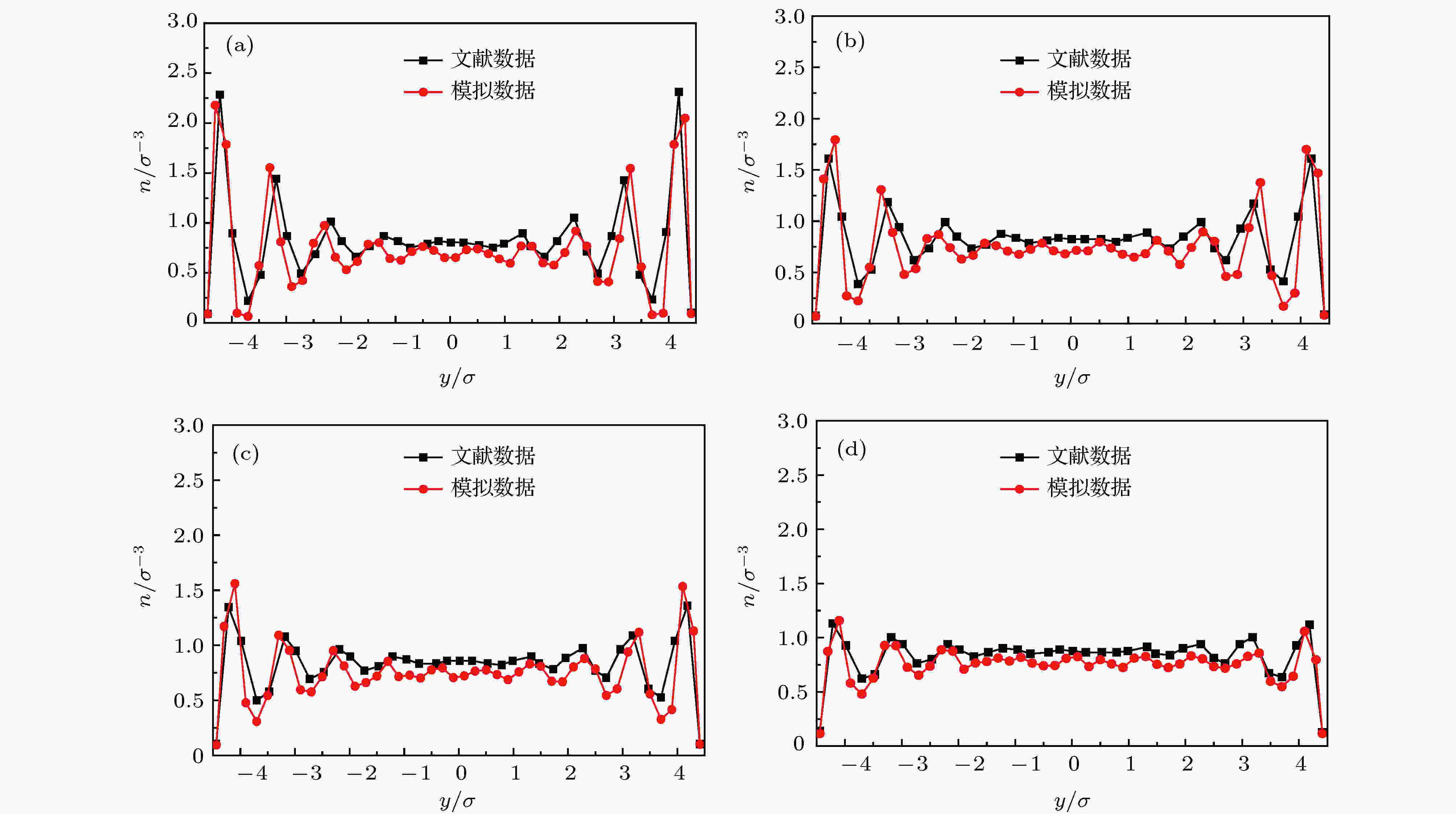 图 3 不同势能系数c下流体沿z方向的密度分布 (a) c = 2.0; (b) c = 1.0; (c) c = 0.6; (d) c = 0.2
图 3 不同势能系数c下流体沿z方向的密度分布 (a) c = 2.0; (b) c = 1.0; (c) c = 0.6; (d) c = 0.2Figure3. Density profiles in the z-direction with different energy coefficient c: (a) c = 2.0; (b) c = 1.0; (c) c = 0.6; (d) c = 0.2.
4.1.壁面粗糙度变化对流动特性的影响
本节以固液原子间势能系数c = 0.75, 对应的光滑接触角θ = 60°时的工况为例. 通过改变粗糙壁面上肋高及肋间距研究壁面粗糙度对通道内流体数密度及速度分布的影响.3
4.1.1.数密度分布
为研究肋高变化对近壁区流体数密度的影响, 固定肋间距






 图 4 肋高h对壁面附近流体数密度分布的影响 (a)粗糙壁面; (b)光滑壁面
图 4 肋高h对壁面附近流体数密度分布的影响 (a)粗糙壁面; (b)光滑壁面Figure4. Effect of rib height h on the distribution of fluid number density near wall surface: (a) Rough wall surface; (b) smooth wall surface.
 图 5 肋间距a对壁面附近流体数密度分布的影响 (a)粗糙壁面; (b)光滑壁面
图 5 肋间距a对壁面附近流体数密度分布的影响 (a)粗糙壁面; (b)光滑壁面Figure5. Effect of rib spacing a on the distribution of fluid number density near wall surface: (a) Rough wall surface; (b) smooth wall surface.
3
4.1.2.速度分布
壁面粗糙度变化引起的通道内流体数密度的变化, 也会导致通道内流体流速分布的变化. 为确定模型水动力位置, 分别计算Couette流动及Poiseuille流动时通道内的速度分布, 更深一步地分析边界滑移机理. 图6(a)和图6(b)为不同肋高对两种流动状态下速度分布的影响, 横坐标为沿y方向上的通道高度分布, 纵坐标为无量纲速度
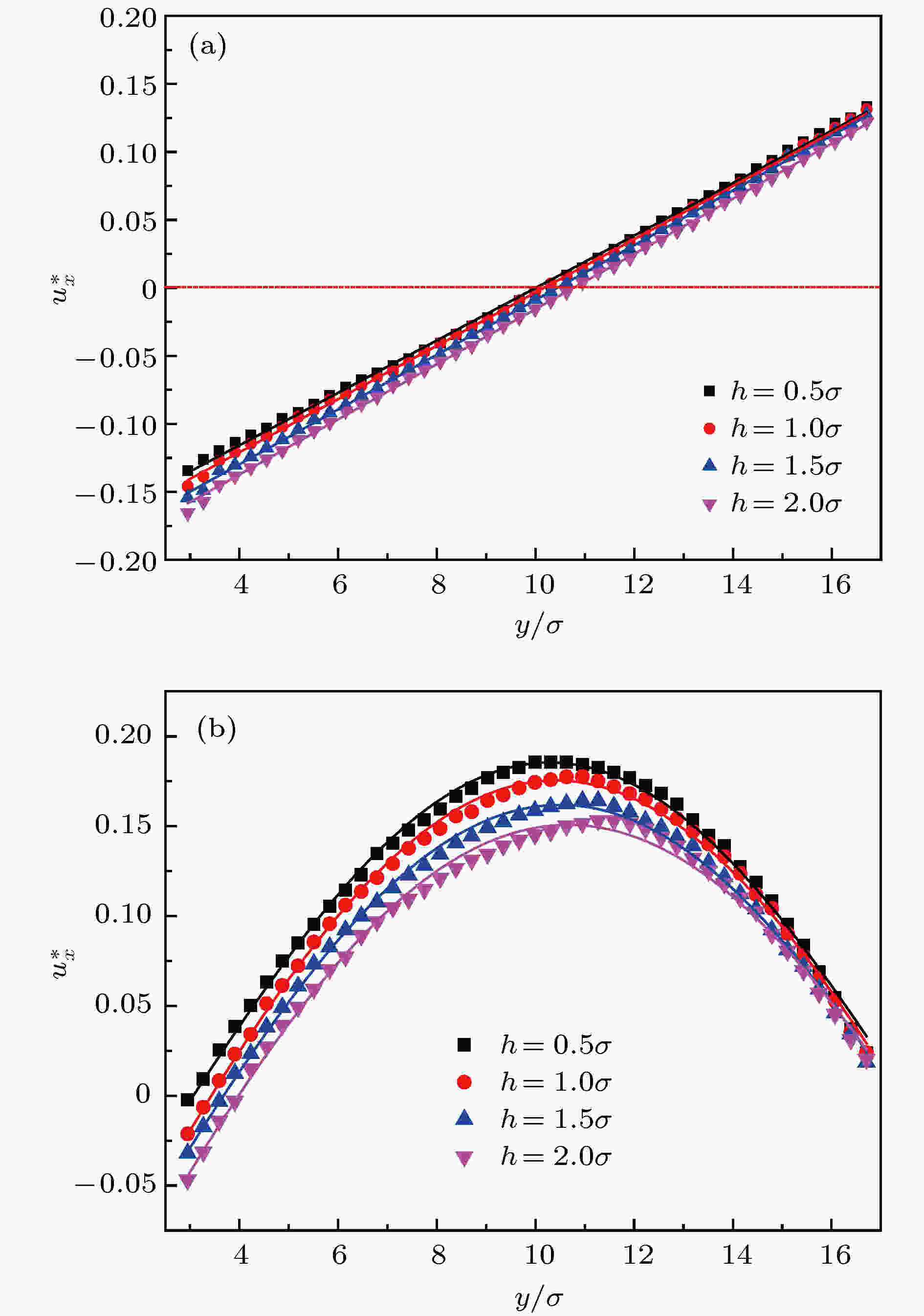 图 6 不同肋高h下流体沿y方向的速度分布 (a) Couette流动; (b) Poiseuille流动
图 6 不同肋高h下流体沿y方向的速度分布 (a) Couette流动; (b) Poiseuille流动Figure6. Velocity profiles in the y-direction with different rib height h: (a) Couette flow; (b) Poiseuille flow.
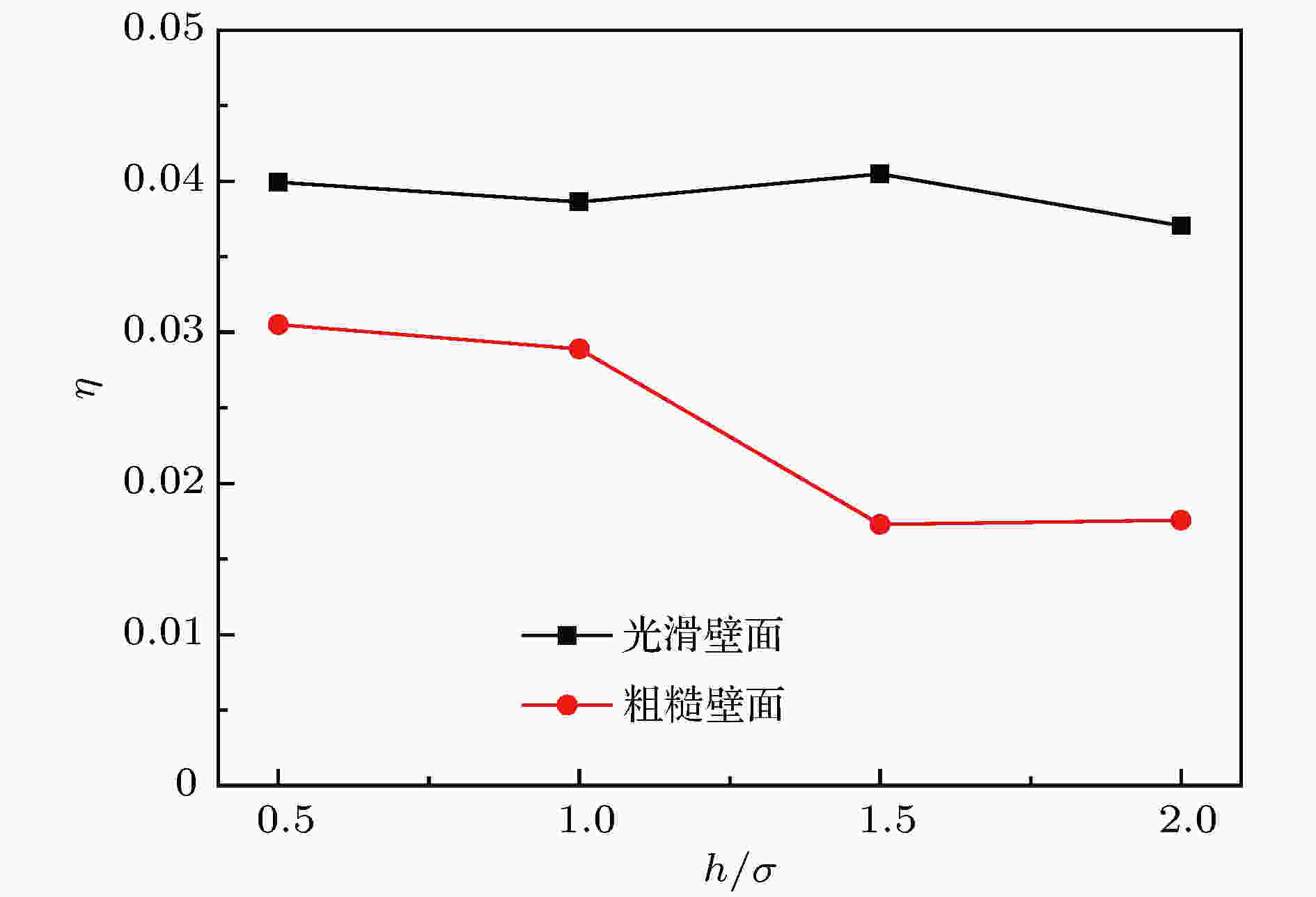 图 7 不同肋高h下滑移长度标准差分布
图 7 不同肋高h下滑移长度标准差分布Figure7. Standard deviation distribution of slip length with different rib height h.
 图 8 (a) 肋高h对滑移长度的影响; (b) 肋高h对滑移速度的影响
图 8 (a) 肋高h对滑移长度的影响; (b) 肋高h对滑移速度的影响Figure8. (a) Effect of rib height h on the slip length; (b) effect of rib height h on the slip velocity.
 图 9 不同肋间距a下流体沿y方向的速度分布 (a) Couette流动; (b) Poiseuille流动
图 9 不同肋间距a下流体沿y方向的速度分布 (a) Couette流动; (b) Poiseuille流动Figure9. Velocity profiles in the y-direction with different rib spacing a: (a) Couette flow; (b) Poiseuille flow.
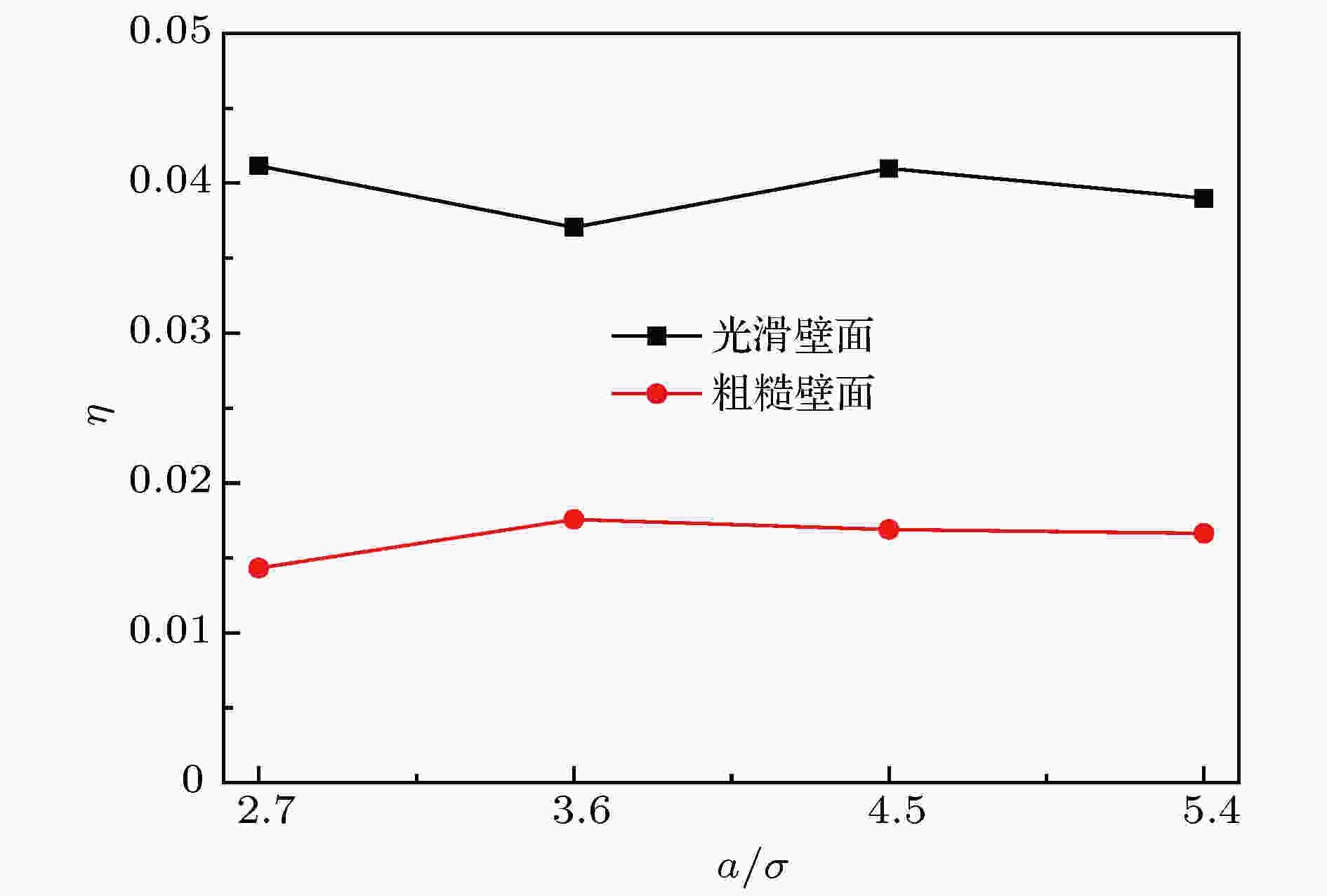 图 10 不同肋间距a下滑移长度标准差分布
图 10 不同肋间距a下滑移长度标准差分布Figure10. Standard deviation distribution of slip length with different rib spacing a.
 图 11 (a) 肋间距a对滑移长度的影响; (b) 肋间距a对滑移速度的影响
图 11 (a) 肋间距a对滑移长度的影响; (b) 肋间距a对滑移速度的影响Figure11. (a) Effect of rib spacing a on the slip length; (b) effect of rib spacing a on the slip velocity.
2
4.2.壁面润湿性变化对流动特性的影响
34.2.1.壁面润湿性变化对数密度的影响
壁面润湿性决定了固体壁面与流体间的相互作用, 不仅会影响固液界面处动量的传递, 也会改变近壁区流体原子的分布状态[25]. 为研究壁面润湿性对微通道内流动的影响, 固定凹槽高度

 图 12 势能系数c对壁面附近流体数密度分布的影响 (a)粗糙壁面; (b)光滑壁面
图 12 势能系数c对壁面附近流体数密度分布的影响 (a)粗糙壁面; (b)光滑壁面Figure12. Effect of energy coefficient c on the distribution of fluid number density near wall surface: (a) Rough wall surface; (b) smooth wall surface.
3
4.2.2.壁面润湿性变化对速度分布的影响
图13为势能系数c变化对两种流动状态下通道内速度分布的影响. 结果显示, 随着势能系数c的增大, 固液原子间的作用力逐渐增强, 两种流动状态下速度分布呈现相反的变化趋势. 如图13(a)所示, Couette流动中通道内的速度分布随着势能系数c的增大而增大, 而图13(b)显示Poiseuille流动中通道内的速度分布随势能系数c的增大而减小. 另外值得一提的是, 对于Couette流动来说, 粗糙壁面附近流体速度变化幅度要大于光滑壁面一侧, 而Poiseuille流动则刚好相反. 图14为不同势能系数c下滑移长度标准差分布. 图15(a)和图15(b)分别为Poiseuille流动中通道内的滑移速度及滑移长度分布, 可以发现, 随着势能系数c的增大, 无论是光滑壁面还是粗糙壁面, 滑移速度和滑移长度分布均逐渐降低. 通过分析可知, 改变势能系数c会影响通道内的速度分布, 使水动力位置发生变化, 并对边界滑移影响较大. 图 13 不同势能系数c下流体沿y方向的速度分布 (a) Couette流动; (b) Poiseuille流动
图 13 不同势能系数c下流体沿y方向的速度分布 (a) Couette流动; (b) Poiseuille流动Figure13. Velocity profiles in the y-direction with different energy coefficient c: (a) Couette flow; (b) Poiseuille flow.
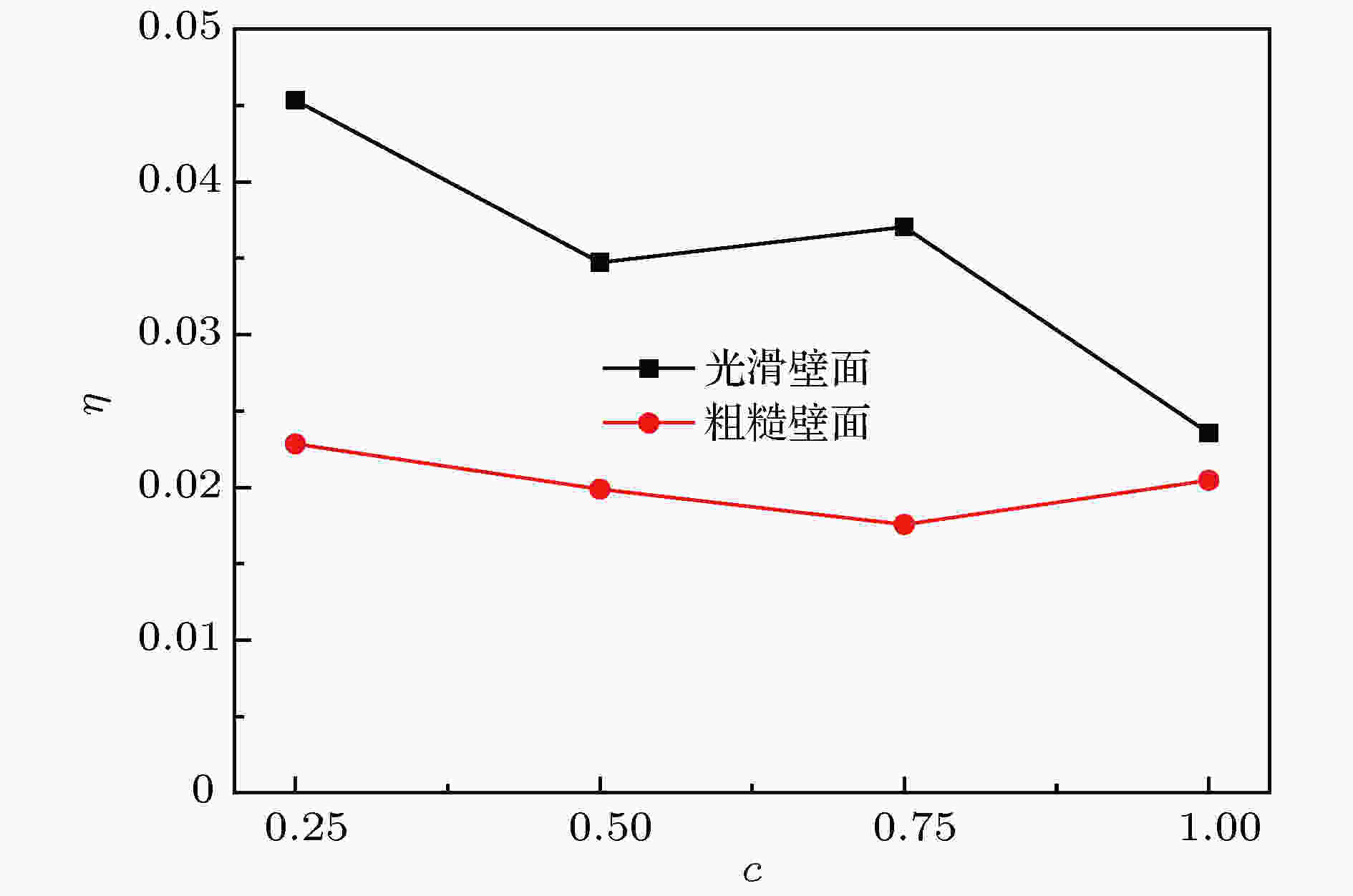 图 14 不同势能系数c下滑移长度标准差分布
图 14 不同势能系数c下滑移长度标准差分布Figure14. Standard deviation distribution of slip length with different energy coefficient c.
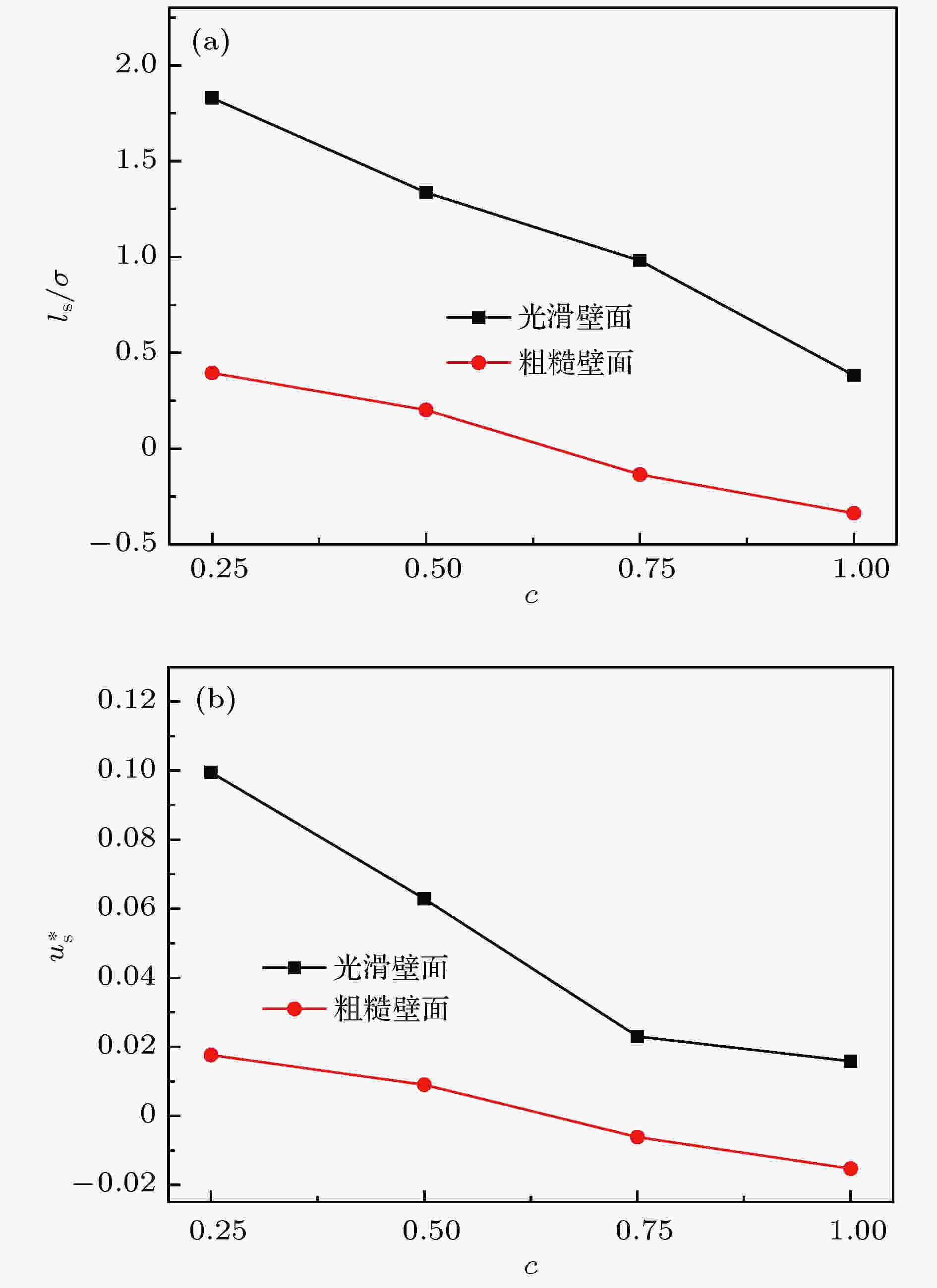 图 15 (a) 势能系数c对滑移长度的影响; (b) 势能系数c对滑移速度的影响
图 15 (a) 势能系数c对滑移长度的影响; (b) 势能系数c对滑移速度的影响Figure15. (a) Effect of energy coefficient c on the slip length; (b) effect of energy coefficient c on the slip velocity.
1)相比于光滑壁面, 粗糙壁面附近流体的数密度分布较低, 随着肋高的增大, 密度波动呈现一次回升现象; 改变肋间距对近壁区流体影响较小, 数密度波动趋势基本一致; 无论是光滑壁面还是粗糙壁面, 增大壁面润湿性均会使近壁区数密度波动增大.
2)通过分析Couette流动和Poiseuille流动时通道内的速度场分布确定模型的固液边界位置. 分析结果表示, 改变肋高及壁面润湿性会明显影响通道内的速度分布, 使固液边界位置发生偏离, 而肋间距变化对固液边界位置影响较小.
3)以Poiseuille流动为主, 分析了壁面粗糙度及润湿性对界面滑移的影响. 结果表明, 粗糙壁面一侧滑移速度及滑移长度均小于光滑壁面一侧, 且随着肋高及壁面润湿性的增大, 滑移速度和滑移长度逐渐减小; 肋间距变化对界面滑移影响较小, 滑移速度及滑移长度分布基本恒定.
